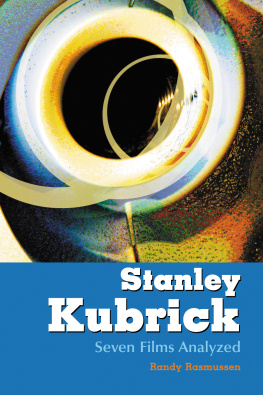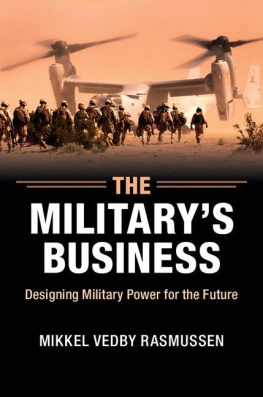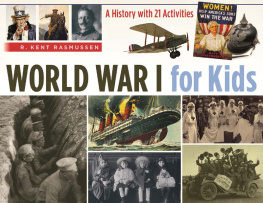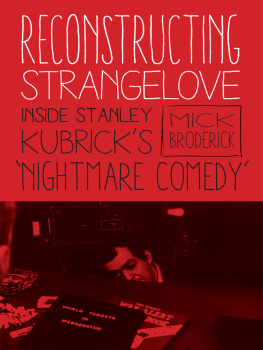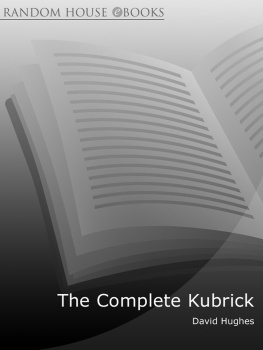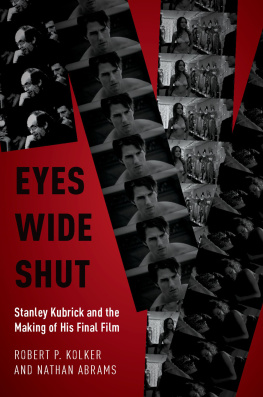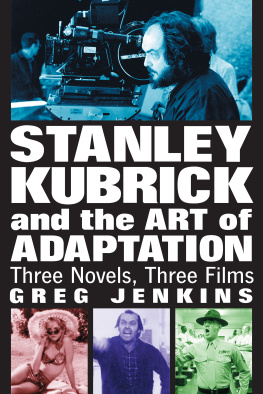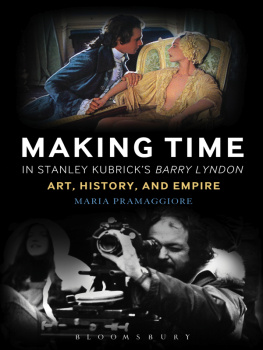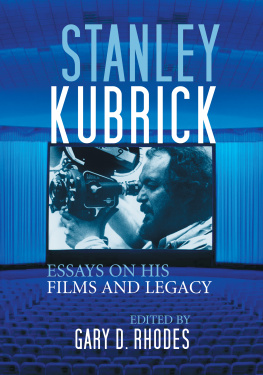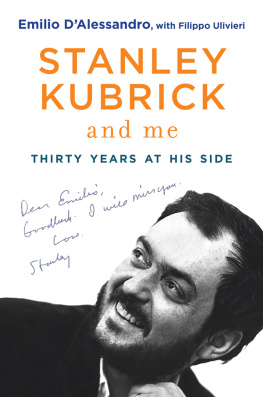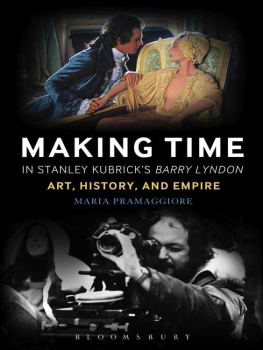
Also by Randy Rasmussen
and from McFarland
Psycho, The Birds and Halloween: The Intimacy of Terror in Three Classic Films (2014)
Children of the Night: The Six Archetypal Characters of Classic Horror Films (1998; paperback 2006)
Orson Welles: Six Films Analyzed, Scene by Scene (2006)
Stanley Kubrick
Seven Films Analyzed
Randy Rasmussen

McFarland & Company, Inc., Publishers
Jefferson, North Carolina
LIBRARY OF CONGRESS CATALOGUING DATA ARE AVAILABLE
BRITISH LIBRARY CATALOGUING DATA ARE AVAILABLE
e-ISBN: 978-1-4766-1376-5
2001 Randy Rasmussen. All rights reserved
No part of this book may be reproduced or transmitted in any form or by any means, electronic or mechanical, including photocopying or recording, or by any information storage and retrieval system, without permission in writing from the publisher.
Cover photograph 2004 PhotoSpin
McFarland & Company, Inc., Publishers
Box 611, Jefferson, North Carolina 28640
www.mcfarlandpub.com
To Stanley Kubrick, for obvious reasons, and to Nicole, for reasons less obvious
Acknowledgments
My thanks to Michael and Jeanne Anderegg and to Donald and Joann McCaffrey for their many years of encouragement and conversation about Kubrick. Also thanks to Barb Hobart, for helping me cope with a temperamental computer, and to Renee Twite, for being a friend. And a special thanks to my father, Loren, and my sister, Terri, for their love and support.
Introduction
You can start with a game plan but depending on where the ball bounces and where the other side happens to be, opportunities and problems arise which can only be effectively dealt with at that very moment.
Stanley Kubrick (Ciment, 175)
Stanley Kubrick made the above comment while comparing filmmaking to a sporting contest, but it could just as easily apply to any of the major characters in his films. Each of them struggles to master the conditions of his or her lifeto impose a pleasing order on the world. And in doing so each character encounters a kaleidoscope of circumstances which present a confusing, ever-changing series of opportunities and problems.
One historical paradigm for the quest of mastering ones self and ones environment is Napoleon Bonaparte, about whom Kubrick once hoped to make a movie. Considered from a variety of perspectives, the French emperor yields contradictory impressions. Destroyer of whatever shreds of idealism remained to revolutionary France, he nevertheless left Europe with a legacy that eroded opposition to those ideals. As a military leader, he was a genius at capitalizing on opportunities that presented themselves and at creating opportunities where conventional military wisdom saw none. But, as time marched on, his battlefield tactics became a definable system, subject to imitation and calculated counterattack.
Kubricks fictional universes too are places of constant change. Environments change. The cast of characters changes. And individual characters change: physically, emotionally, and intellectually. In the course of seven meticulously wrought films, from Dr. Strangelove through Eyes Wide Shut, Stanley Kubrick passionately dramatized the complexity and mutability of human struggle, in settings and situations so diverse that some of his critics fail to see the common threads in his works. The goal of this book is to trace some of those threadsto describe the shifting patterns of strategic, moral, and aesthetic relationships among the characters (individual and collective) and environments (natural and artificial) that Kubrick sets in motion. Like chess, one of Kubricks favorite pastimes, each move by one piece can alter relationships among all other pieces involved in the action, as well as change our understanding of all previous moves.
Few artists are as thorough in their delineation of character and environment, or in their orchestration of complex events, as Kubrick. In order to preserve some sense of the dramatic flow he generates, I chose to explore each of the films in this book scene by scene instead of organizing the discussion by thematic categories. One of the joys of viewing a Kubrick film is to experience the intense lyricism of precisely sculpted impressions that build on one another. The risk of my approach to Kubricks lyricism is that of lapsing into pointless synopsizing, which I have tried to avoid. Yet it is remarkable how much viewers can disagree about the details of what they saw and heard in a given film.
Kubricks camera acts as a roving participant/observer, slipping into and out of intimate alignment with the various perspectives of his characters. In The Shining, for example, it tracks members of the Torrance family through the maze of corridors in the Overlook Hotel, functioning alternately as purely subjective double, partly subjective companion, detached observer and occasionally even metaphorical predator. Kubricks use of sound, especially music, is equally dynamic, sometimes reinforcing and sometimes contradicting visual impressions. Kubricks cinematic universe is an endless lyrical dance featuring multiple partners in constant movement. By infusing each of these partners with its own dramatic integrity while not allowing any one of them to completely dominate the story, Kubrick strives for a comprehensive perspective that eludes his characters.
Anthropologist Germaine Tillion wrote about the dilemma of objective versus subjective points of view in her study of Nazi atrocities during World War II. Speaking as both a victim of the Holocaust and a professional student of people and their institutions, she notes:
The pervasive element of bias will always affect interpretation, of course, and it is almost impossible to dislodge. But conversely, a total absence of emotional involvement amounts to almost unbelievable incomprehension. There is a very narrow line between bias and incomprehension, and this narrowness is one of the most basic problems of humanity and history [Tillion, 201].
Journalist Thomas L. Friedman, reporting on Middle Eastern affairs during the 1980s, described a similar tension in his job: Intimacy without disinterest lapses into commitment to one side or another; disinterest without intimacy lapses into banality and misunderstanding (Friedman, 69).
Kubricks films are juggling acts in which he tries to bring many ingredients vividly to life without losing track of their interaction. Narrative film is an abstract representation of reality that bridges the gap between bias of the moment and total absence of emotional involvement. The audience gets to have its cake and eat it too. Perhaps for that reason Kubrick is sensitive to films capacity for deception, often drawing comparisons between film and the various abstract visual filters of his characters. In 2001: A Space Odyssey, for example, the widescreen film frame parallels numerous examples of artificially contained or modified perspective within it. Sometimes we see subjectively with and other times objectively beyond what the characters see. In Dr. Strangelove, General Turgidsons beloved Big Board is a glorified movie screen that provides him with a simplified, abstract, and manageable impression of nuclear war quite different from the messy realities we encounter outside its borders. Alex, in
Next page
